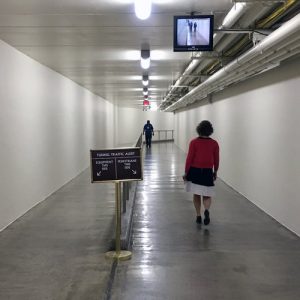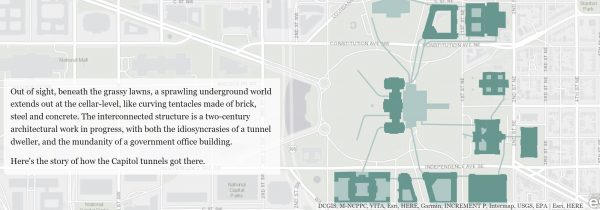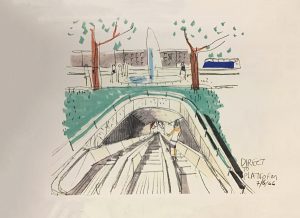We’re kicking off the new year at 99pi with a fresh installment of mini-stories, including: a strange collision of mundane infrastructure and political insurrection; a graphic design history mystery dating back to the 1980s; what may be the most hated architectural design of 2021; and a record-breaking album cover design so cutting edge it cost more money to make than to buy. Tune in next week for one more set of minis before we return to our regularly scheduled programming!
Infrastructure & Insurrection by Delaney Hall

Elliot Carter was born and raised in Washington, DC, and while working a Capitol Hill internship discovered a love for the networks of tunnels running under the capitol. His interest in the these tunnels led him to delve into their history, which dates back to the era of the Civil War.

Some of them were to move books at high speed between the Library of Congress and the capitol. Some of them housed these huge underground air ducts that used to be packed with ice — a kind of low-tech air conditioning attempt. And in the early 1900s, there came the subways for members of Congress and their staff to get around the capitol quickly. Eventually, Carter expanded his interest to all kinds tunnels sprawling around the city, and compiled his findings on a website.

The site became popular among local history buffs and the DC architecture community, but then, in early 2021, he started noticing an unusual spike in traffic from odd sources, including militia websites. Tracing this traffic back, he found marked-up images indicating routes for “patriots” to enter, block off, or escape through, like battle plans. In short: these were the people who were planning the January 6th insurrection, and they were using his maps to talk about how they’re going to surround and infiltrate the Capitol.
 Carter was sufficiently troubled to sent a tip to the FBI, but never heard back. Then, on the 6th, he opened up his Google Analytics account and was horrified to see hundreds of people on the page at one time (which was far higher than a typical day). So Elliot ended up pulling the site down for a time, just so he could have time to look back through it, line by line, and think about the information he’d shared and if any of it should be changed. And he ultimately concluded the answer was no — he felt like he’d presented the information responsibly, it had all been stuff in the public domain, and so he put it back up.
Carter was sufficiently troubled to sent a tip to the FBI, but never heard back. Then, on the 6th, he opened up his Google Analytics account and was horrified to see hundreds of people on the page at one time (which was far higher than a typical day). So Elliot ended up pulling the site down for a time, just so he could have time to look back through it, line by line, and think about the information he’d shared and if any of it should be changed. And he ultimately concluded the answer was no — he felt like he’d presented the information responsibly, it had all been stuff in the public domain, and so he put it back up.
 Carter never was contacted by the FBI, but eventually the Senate Rules Committee published their first investigative report into the attack and it had a couple footnotes that referenced the tip that Elliot had submitted before the insurrection happened. Later, he was contacted by the House Committee investigating January 6th and had a conversation with them about the tip he made, to help determine if law enforcement overlooked something. Today, Carter feels more strongly than ever that there’s kind of a public service element to his site. He wants people to know about these tunnels and about their real history.
Carter never was contacted by the FBI, but eventually the Senate Rules Committee published their first investigative report into the attack and it had a couple footnotes that referenced the tip that Elliot had submitted before the insurrection happened. Later, he was contacted by the House Committee investigating January 6th and had a conversation with them about the tip he made, to help determine if law enforcement overlooked something. Today, Carter feels more strongly than ever that there’s kind of a public service element to his site. He wants people to know about these tunnels and about their real history.



Comments (10)
Share
Re: Mini Stories episode 13. I hope the design of that dorm can be changed. The idea of living in a small space is bad enough but a small space with no window gives me physical shivers of claustrophobia! The other bad idea is that making the individual rooms so unappealing as to force the students into the common areas sounds logical but doesn’t work in practice. I had friends who lived in a subsidized co-housing community in Fairfax. It was designed for single moms and for elderly residents. (They were supposed to mix and be good for each other. That didn’t work. The elderly residents from the four buildings mutinied and banded together in one building.) The rooms for the individuals were tiny and once again the idea was to push everyone to use the common living room and kitchen. It didn’t really work well. I believe that good and thoughtful design can create spaces that can encourage certain human behaviors but this idea of making individual private rooms too small to force people out into the open is not good or thoughtful.
On the Jazz paper cup design, I just had to let you know that my high school graduating class of 1972 chose that turquoise-blue and purple as our colors.
More spacious and with more options to explore outside than my accommodation in Antarctica, Not sure what the problem is.
Looking at the jazzy cup design makes me wonder if Gina Ekiss is left-handed….
The strokes in the design seem difficult for me (a right handed person) to recreate!
Roman misunderstood the term “subway” to mean underground trains, which would have been incredibly inefficient for the short distances involved. It’s obvious that the “subway” was just and underground pedestrian tunnel. Besides the conventional contemporary meaning of the word, part of the confusion probably stemmed from the story reference to “move books at high speed,” but this was most likely done with carts.
that the record label lost money on blue monday isn’t correct–they just made VERY little. and the label quickly altered subsequent pressings to recoup costs more quickly. any record collector pretty much knows this story and has seen the iterations. the iterations are actually as much a part of the story, too.
you can find this info lots of places, but i will link you to the discogs listing as just one example.
You can see the subway in the movie “advise and consent”
Are there ANY building codes in USA / California? It’s easy to see that building is a death trap in a fire. Look at length of the exit paths from the central rooms to the stairwells. Then imagine the crowd of students trying to access a stairwell – but there are doors on both sides of the top landing, so opening a door pushes into people already on the stairs and coming into the stairwell on the other side. This design wouldn’t get approved in Australia. Oh, and habitable rooms (ie ones people use) have to have natural light, openable windows and natural ventilation in Oz too. Also, the complete lack of consideration for disabled. Will they miraculously carry their wheelchairs down the stairs in a fire? Can they even access the building at all?
I was surprised by the assertions about the 12-inch recording being the “most popular 12-inch of all time.” Maybe I misunderstood and it was said it was the most popular 12-inch “single,” or something like that. But having thrived through that era I can confidently say that neither I nor anyone I’ve checked with has any idea about “Blue Monday.” No one I know has ever heard of it or recognizes it. And saying it was the most popular…let’s say, 12-inch single…is like saying, well, like saying something that very very few people have ever heard of is the most popular thing in its class.
Oh, and I love the podcast…other than this one.
And although I’ve been in hundreds of coffee shops, I don’t think I’ve ever seen the “jazz cup.” Maybe I need to get out more.
When listening to the Jazz design segment I got excited when you mentioned my home town where Imperial cup was located. Imperial cup was in Kenton Ohio, not Canton. This is a common mixup sadly. The company is now named International paper. Great program though.
I’d love to hear a 1.2 version about the dorm, particularly the comparison to jails. There are actually minimum size requirements per state for single and double cells. And access to light and air. Lately, some of the larger jail systems (LA, Wayne, Cook County and NYC) are undergoing a reform with ew buildings. Recommendation and requirements reach the level of access to daylight and views (i.e. a window in the cell not just a view from the cell through a room to another window).
As a justice architect, I’d also love to see a crossover with Earhustle about jail and prison buildings. But that’s a whole new level of niche nerdiness.